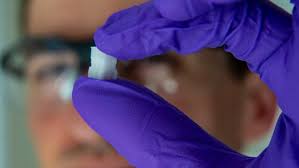
Breaking News
 New York rocked by 'explosion' as black smoke chokes Manhattan neighborhood
New York rocked by 'explosion' as black smoke chokes Manhattan neighborhood
 10 Ways Gov't-Compliant Stablecoins Are Functionally No Different Than CBDCs
10 Ways Gov't-Compliant Stablecoins Are Functionally No Different Than CBDCs
Top Tech News
 1,000 miles: EV range world record demolished ... by a pickup truck
1,000 miles: EV range world record demolished ... by a pickup truck
 Fermented Stevia Extract Kills Pancreatic Cancer Cells In Lab Tests
Fermented Stevia Extract Kills Pancreatic Cancer Cells In Lab Tests
 3D printing set to slash nuclear plant build times & costs
3D printing set to slash nuclear plant build times & costs
 You can design the wheels for NASA's next moon vehicle with the 'Rock and Roll Challenge
You can design the wheels for NASA's next moon vehicle with the 'Rock and Roll Challenge
 'Robot skin' beats human reflexes, transforms grip with fabric-powered touch
'Robot skin' beats human reflexes, transforms grip with fabric-powered touch
 World's first nuclear fusion plant being built in US to power Microsoft data centers
World's first nuclear fusion plant being built in US to power Microsoft data centers
 The mitochondria are more than just the "powerhouse of the cell" – they initiate immune...
The mitochondria are more than just the "powerhouse of the cell" – they initiate immune...
 Historic Aviation Engine Advance to Unlock Hypersonic Mach 10 Planes
Historic Aviation Engine Advance to Unlock Hypersonic Mach 10 Planes
 OpenAI CEO Sam Altman Pitches Eyeball-Scanning World ID to Bankers
OpenAI CEO Sam Altman Pitches Eyeball-Scanning World ID to Bankers
 New 3D-printed titanium alloy is stronger and cheaper than ever before
New 3D-printed titanium alloy is stronger and cheaper than ever before
3D-printed material is designed to treat difficult bone injuries

The long bones in our arms and legs have a layer of smooth, compressible cartilage at each end, which gradually transitions to hard bone underneath. This dual-density combo is known as osteochondral tissue, and when it develops cracks or otherwise gets damaged, conditions such as disabling arthritis can result. Although such injuries frequently afflict athletes, they can occur in pretty much anyone.
For injuries to more uniform types of bone, various scientific institutions have created the previously-mentioned scaffolding. Implanted at the injury site, the three-dimensional material basically provides a roosting site for bone cells, helping them to move in from the adjacent bone and start reproducing. Eventually, they simply take over from the material, replacing it as it harmlessly dissolves.
Now, researchers from the University of Maryland and Houston-based Rice University have developed a version of this material that's tailored to healing osteochondral tissue.

 THE POWER OF PLANTING A SEED
THE POWER OF PLANTING A SEED  Militarizing the Capital
Militarizing the Capital

